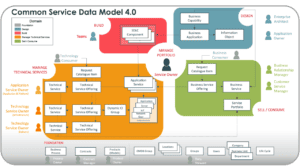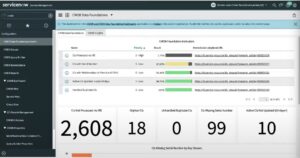The Common Service Data Model (CSDM) in ServiceNow is a standardized framework that helps organizations structure and manage their configuration items (CIs), CMDB (Configuration Management Database), and services within the ServiceNow platform. It provides a consistent way to define and relate different aspects of IT services and business services, enabling better visibility, management and reporting.
Main components of CSDM:

1. Foundation Data:
- Location: Physical locations where services are provided.
- User: People or groups who use the services.
- Company: Legal entities that own the services.
2. Design:
- Services Portfolio: Catalog of commercial and technical services.
- Business Service: Services provided to the company.
- Technical Service: IT services that support business services.
3. Manage Technical Services:
- Application Services: Grouping of ICs that deliver applications.
- Infrastructure Services: Grouping of ICs that deliver infrastructure.
4. Sell/Consume:
- Offers: Descriptions of services available to consumers.
- Service Catalog: Collection of offers available for request.
5. Manage Business Services:
- Business Capabilities: High-level skills that the organization needs.
- Business applications: Applications that support business features.
Benefits of CSDM:
- Improved Service Management: Provides a clear framework for managing services and CIs, improving the management of incidents, problems, changes and services.
- Improved reporting and analysis: Facilitates better reporting and analysis due to standardized data.
- Greater visibility: Provides better visibility into the relationships between services and their supporting infrastructure.
- Alignment with Best Practices: Aligns with ITIL and other industry best practices, ensuring a robust IT service management framework.
Implementing CSDM in ServiceNow:
- Evaluate current data: Evaluate existing data and its alignment with CSDM standards.
- Define the CSDM framework: Customize the CSDM framework to meet your organization's specific needs.
- Data migration and cleaning: Migrate existing data to the CSDM framework and clean up any inconsistencies.
- Ongoing governance: Establish governance processes to maintain data quality and compliance with CSDM standards.
By joining CSDM, organizations can gain a more organized and efficient approach to managing their IT and business services in ServiceNow.
The Common Service Data Model (CSDM) and Configuration Management Database (CMDB) in ServiceNow are closely related concepts that work together to improve IT service management. Here's a breakdown of how they interact and complement each other:
Configuration Management Database (CMDB):
CMDB is a repository that stores information about IT infrastructure, including details about configuration items (CIs) such as servers, applications, network devices, and relationships between them. It serves as a central source of truth for IT environments, providing visibility into the components that make up IT services.
Main features of CMDB:
- Centralized data storage: Aggregates data from multiple sources into a single repository.
- Relationship Mapping: Tracks dependencies and relationships between CIs.
- Change Management: Facilitates the analysis and management of the impact of changes through understanding CI interdependencies.
- Incident and Problem Management: Supports root cause analysis and resolution by providing detailed CI information.
- Compliance and Auditing: Ensures compliance with policies and regulations through detailed monitoring and reporting.
Main components of CSDM:
- Foundation Data: Basic elements such as locations, users and companies.
- Design: Structures business and technical services, service portfolios and relationships.
- Manage Technical Services: Focuses on application and infrastructure services.
- Sell/Consume: Includes service offers and catalogs.
- Manage business services: Defines business resources and applications.
How CSDM Enhances CMDB:

1. Standardization:
CSDM provides a consistent and standardized way to structure and relate CIs and services within the CMDB, ensuring that data is organized in a logical and comprehensive manner.
2. Improving data quality:
By following CSDM guidelines, organizations can improve the accuracy and completeness of CMDB data, leading to more reliable insights and decision-making.
3. Improved Visibility:
The CSDM framework makes it easy to visualize the relationships between business services, technical services, and the underlying infrastructure, increasing overall service visibility.
4. Better alignment with best practices:
CSDM aligns with ITIL and other best practices, helping organizations adhere to industry standards and improve their IT service management processes.
5. Reporting and Analysis Made Easy:
With a standardized data model, organizations can produce more consistent and meaningful reporting and analysis, leading to better performance tracking and management.
Implementing CSDM in CMDB:
1. Assessment and Planning:
Assess the current CMDB structure and data quality. Define a roadmap for adopting CSDM standards.
2. Data Model Customization:
Customize the CSDM framework to meet the organization's specific needs.
3. Data cleaning and migration:
Clean up existing CMDB data and migrate it to align with CSDM standards.
4. Ongoing maintenance:
Establish governance processes to ensure ongoing data quality and adherence to the CSDM framework.
Conclusion:
CSDM provides the model for structuring and managing data within the CMDB, increasing its effectiveness and usefulness. Together, they form a powerful combination that improves IT service management, increases visibility into IT environments, and aligns with industry best practices such as ITIL, COBIT, and ISO 19770
